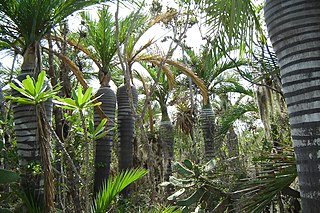
Obregonia, the artichoke cactus, is a monotypic genus of cacti, containing the species Obregonia denegrii. The species is endemic to the state of Tamaulipas in Mexico.

Bactris setulosa is a medium-sized spiny palm which is found in Colombia, Venezuela, Ecuador, Peru, Trinidad and Tobago and Suriname. It is one of the largest species of Bactris and is found at the highest elevations.

Gaussia is a genus in the palm family, native to Mexico, Central America and the Greater Antilles. They are solitary, unarmed, and have pinnately compound leaves. The trees have enlarged bases and prop-roots.

Pseudophoenix ekmanii is a palm species endemic to the Barahona Peninsula and Isla Beata in the Dominican Republic on the Caribbean island of Hispaniola.
Arenga micrantha, also known as the Tibetan sugar palm, is a species of flowering plant in the family Arecaceae, found in the cloud forests of Tibet, Bhutan, and North-East India. Its natural habitat is subtropical or tropical moist lowland forests, between 1400 and 2150 m. It is threatened by habitat loss.

Bentinckia condapanna, the hill areca nut, is a species of flowering plant in the family Arecaceae. It is found only in India. It is threatened by habitat loss. This palm is mainly found in the evergreen forests of Western Ghats of India.

Gaussia maya is a palm which is native to Mexico, Belize and Guatemala. The species grows in rocky areas on limestone soils. The species is classified as vulnerable, and is threatened by habitat destruction and degradation.

Itaya amicorum is a medium-size fan palm that is native to Brazil, Colombia and Peru. It is the only species in the genus Itaya. It was unknown to science until 1972, when it was discovered on the bank of the Itaya River in the Peruvian Amazon.

Loxococcus rupicola is a species of palm tree, and the only species in the genus Loxococcus. It is endemic to Sri Lanka. It is threatened by habitat loss.
Rhopaloblaste augusta is a species of flowering plant in the family Arecaceae. It is found on the Nicobar Islands in the Indian Ocean, part of India. It is also found in Peninsular Malaysia & Singapore, the Moluccas, New Guinea & the Solomon Islands. In lowland rain forest. It is threatened by habitat loss.

Schippia concolor, the mountain pimento or silver pimeto, is a medium-sized palm species that is native to Belize and Guatemala. Named for its discoverer, Australian botanist William A. Schipp, the species is threatened by habitat loss. It is the sole species in the genus Schippia.
Wallichia triandra is a species of flowering plant in the family Arecaceae that is native to South Tibet in China and also to the neighboring Arunachal Pradesh region of India.

Pseudophoenix sargentii, commonly known as the Florida cherry palm or buccaneer palm, is a medium-sized palm native to the northern Caribbean, eastern Mexico, and extreme southeast Florida in the United States.
Coccothrinax gundlachii (yuraguana) is a palm which is endemic central and eastern Cuba. Its specific epithet, gundlachii, is in honor of Cuban naturalist Juan Gundlach.
Coccothrinax pauciramosa, the yuraguana or yuraguana vestida, is a palm which is endemic to Cuba. Like other members of the genus, C. pauciramosa is a fan palm. Trees are single-stemmed, between 2 and 5 metres tall with stems 4 to 8 centimetres in diameter. The fruit is purple-black, 0.7–1.2 cm in diameter.

Copernicia baileyana (yarey) is a palm which is endemic to eastern and central Cuba. Like other members of this genus, C. baileyana is a fan palm. Trees are 10 to 20 metres tall with stems 40 centimetres in diameter and are sometimes swollen. The fruit is black, 1.8 to 2.3 centimetres long and 1.8 to 2 cm in diameter.

Gaussia attenuata is a palm which is native to Puerto Rico. The species grows on steep-sided limestone hills in Puerto Rico.
Gaussia spirituana is a palm which is endemic to the Sierra de Jatibonico in east-central Cuba.

Acrocomia is a genus of palms which is native to the Neotropics, ranging from Mexico in the north, through Central America and the Caribbean, and through South America south to Argentina.

Gaussia princeps, commonly known as palma de sierra, is a palm which is endemic to Cuba. The species grows on steep-sided limestone hills in Pinar del Río Province in western Cuba.














